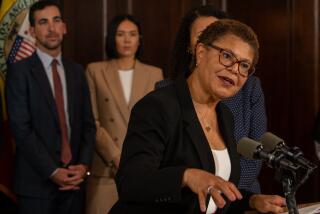Civil Service Protections Are Upheld : Measures: Proposal to change dynamics of City Hall hiring loses for third time in a decade. Two other charter amendments win by comfortable margins.
- Share via
A proposal to strip top bureaucrats in Los Angeles City Hall of Civil Service protection was defeated Tuesday for the third time in a decade.
Charter Amendment 3, which lost by a 55% to 45% margin, was the most far-reaching of three measures on the city ballot. It would have vastly changed the dynamics of hiring and firing in the upper echelons of city government.
“Three times a charm--they shouldn’t bring it up again,” said Councilman Nate Holden, who opposed the measure because he said it would infuse city departments with political interference.
Two other ballot measures were approved by comfortable margins Tuesday. Charter Amendment 1 will allow the city to reduce or eliminate business taxes in economically depressed areas; Charter Amendment 2 will give city pension funds more investment options.
Efforts to increase politicians’ authority over career bureaucrats have appeared on the ballot twice before--in 1983 and 1984--and were defeated both times. During previous years, former Police Chief Daryl F. Gates was a vociferous opponent of the change, arguing that independent managers are an asset and that reining them in would be a return to the old days of bossism.
This year, however, with public attention focused on the successor to Mayor Tom Bradley, none of the ballot measures sparked much debate. There was no organized campaign for or against any of them.
Supporters of Charter Amendment 3, including the majority of the City Council, said it would have forced career bureaucrats to be more productive and allowed elected officials to discipline uncooperative department heads who are now shielded from accountability.
Opponents, who included Holden and Councilman Hal Bernson, argued that the council was really seeking to politicize the city’s departments.
“People must think the Civil Service system is working,” said Council President John Ferraro, who had also opposed the measure.
The proposal would have destroyed “the checks and balances,” Holden said. “The structure is well thought out now. Why change it? The council may be mad at a department head and this is their way of getting even.”
Under the current system, those applying to head city departments must take a Civil Service exam, receive some credit for seniority and are hired by the mayor or the commissions appointed by the mayor. Under this system, the Board of Civil Service Commissioners has the final say on whether a department head should be disciplined or fired, after a series of hearings.
As the long tussle over the removal of Gates showed, Civil Service managers have enjoyed significant protections from the whims of politicians. The proposed system would not have applied to Police Chief Willie L. Williams, who is covered by Charter Amendment F, the police reform measure that limits the chief to two five-year terms.
The measure considered by voters Tuesday would have widened the field for heads of city departments by loosening some of the strict Civil Service guidelines. It would have allowed the mayor to appoint and remove the department heads with the consent of the City Council, making bureaucrats much more dependent on elected officials.
Charter Amendment 1 will allow the city to grant business tax reductions or exemptions in redevelopment areas or enterprise zones. Typically all those engaged in the same type of business have had to pay the same rate of business tax, regardless of location.
Supporters, including RLA, formerly the Rebuild L.A. organization, said the measure enables the city to boost development in those areas most in need by exempting struggling businesses from some local taxes.
Councilman Mark Ridley-Thomas, who introduced the measure, said he pushed for the tax relief because the council was forced to raise business taxes to help balance the budget and he does not want that increase to interrupt the revitalization of South-Central Los Angeles and other areas.
There was no ballot argument submitted against the tax relief, but the Los Angeles Area Chamber of Commerce’s board called it an unfair, selective measure. Another business group, the Valley Industry and Commerce Assn., said it hopes that “areas designated for tax relief do not exclude those communities within the San Fernando Valley that are struggling to survive.”
Charter Amendment 2, which will enable employees’ pension funds to be invested in a broader array of stocks, was supported by Gary Mattingly, head of the city’s Department of Pensions; Oscar Peters, head of the City Employees Retirement System; City Administrative Officer Keith Comrie and the heads of the fire and police unions. There was no ballot argument against the measure.
Up to now, the City Charter has allowed employee pension funds to invest up to 70% of their money in stocks and bonds. Most of those investments must be in securities that are registered on a national securities exchange--such as the New York Stock Exchange or the American Stock Exchange--and that have paid a dividend in each of the preceding five years.
The charter has allowed 25% of the investments to be in securities that are not on a national register and do not have such a history of paying dividends. The ballot measure would increase the 25% figure to 50%, boosting the number of growth stocks available for investment. The measure applies to the Fire and Police Pension System and the City Employees Retirement System.
More to Read
Sign up for Essential California
The most important California stories and recommendations in your inbox every morning.
You may occasionally receive promotional content from the Los Angeles Times.













